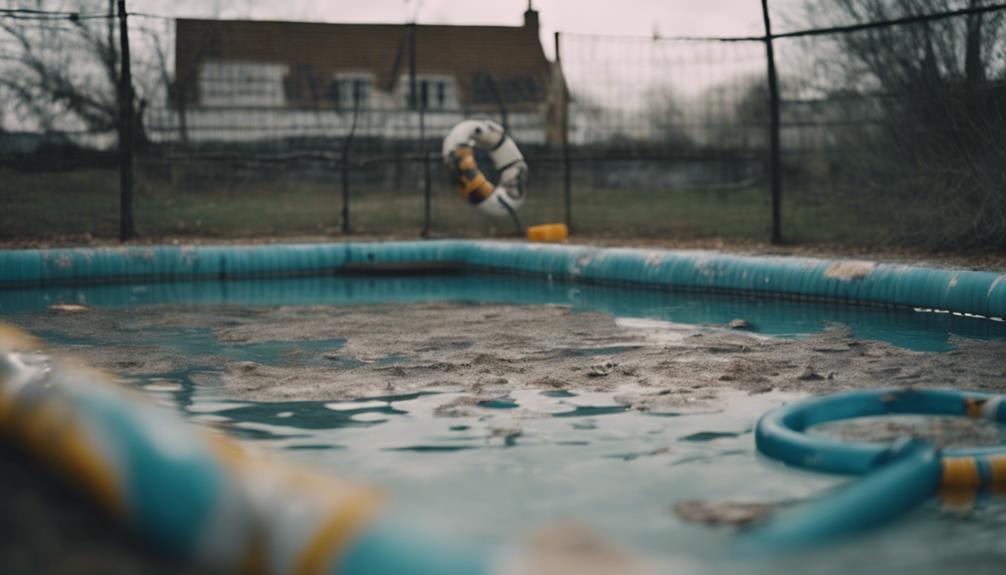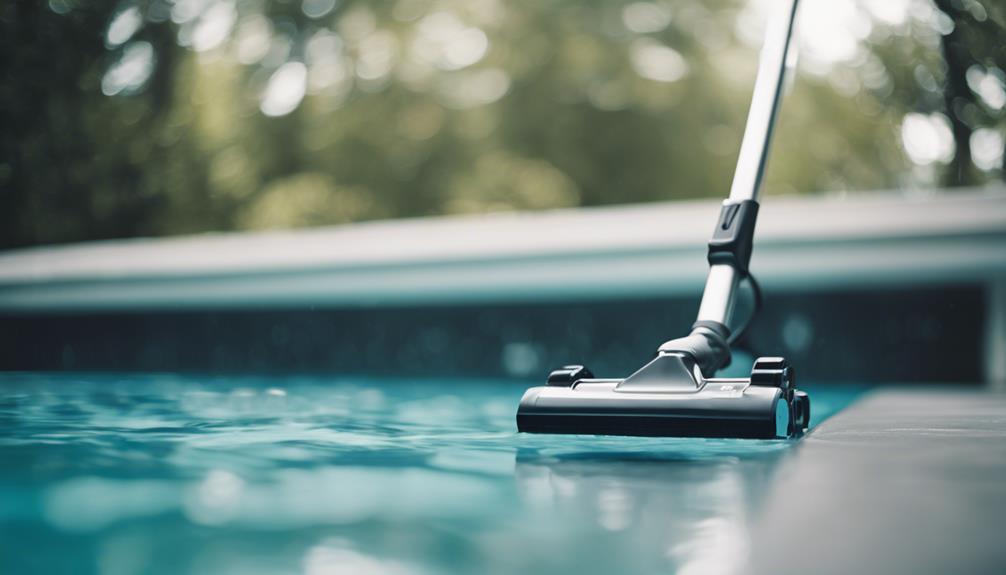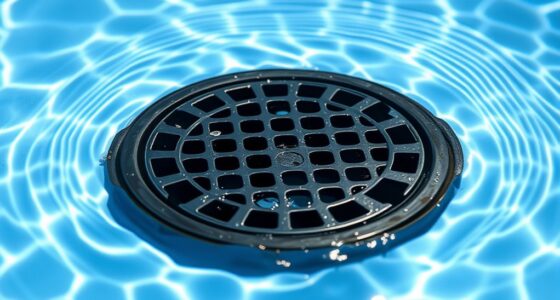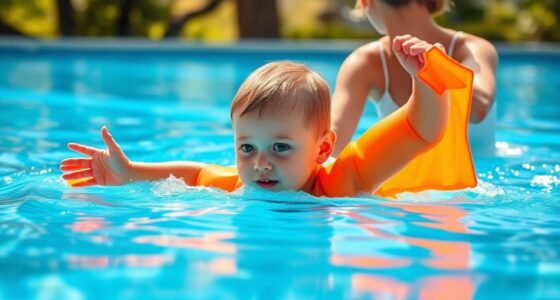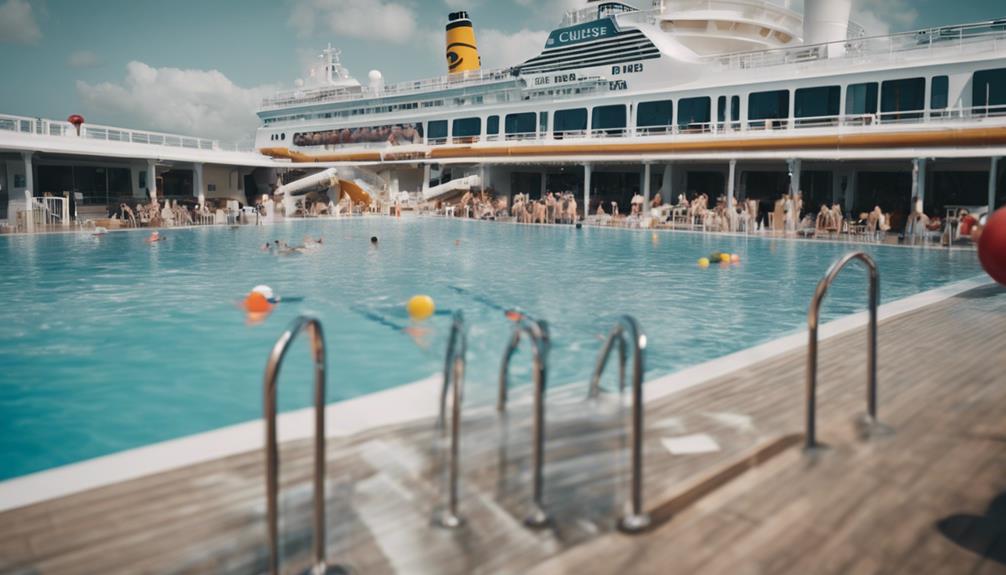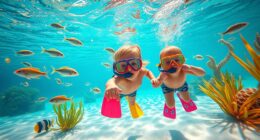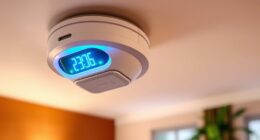Understanding the importance of pool safety is crucial to preventing accidents. Pool drownings are a leading cause of death in young children, especially when proper supervision is lacking. Insufficient barriers can result in tragic consequences. Taking formal swim lessons significantly reduces the risk of drowning. It is important to avoid alcohol near pools as it can impair judgment. Glass containers should be kept away, as they can break and cause harm. Adhering to safety regulations and properly maintaining equipment are essential. Ensuring electrical safety and maintaining a proper chemical balance are key to creating a safe swimming environment. By being aware of these potential risks, you can protect yourself and others.
Key Takeaways
- Lack of proper fencing increases drowning risk dramatically.
- Inadequate adult supervision leads to tragic outcomes.
- Alcohol consumption near pools impairs judgment and coordination.
- Compliance with safety regulations and equipment maintenance are crucial.
- Regular chemical testing and handling prevent health hazards.
Pool Drowning Statistics
When it comes to pool safety, understanding pool drowning statistics is important to prevent tragic accidents. Pool owners play an essential role in maintaining a safe environment for swimmers.
Drowning is the leading cause of death in children under five, with the highest rates seen in 1 to 2-year-olds. On average, 3,536 people drown yearly in the United States, which amounts to around 10 deaths each day.
To mitigate these risks, experts recommend installing a four-sided fence around the pool to reduce the likelihood of drowning incidents. Organizations like the American Red Cross offer crucial guidelines for home pool safety to prevent accidents.
Additionally, teaching children to swim at an early age is key in decreasing the chances of drowning. By staying informed about these statistics and taking necessary precautions, pool owners can greatly enhance the safety of their pool area and protect those who use it.
Lack of Adult Supervision
To guarantee the safety of children around swimming pools, consistent adult supervision is paramount. Lack of adult supervision is a leading factor in pool-related accidents, making it essential for adults to be vigilant when children are near water. Here are some key points to keep in mind regarding the importance of adult supervision in preventing accidents around swimming pools:
| Key Points | Details | Importance |
|---|---|---|
| Drowning as top cause of child death | Lack of adult supervision is the primary reason for drowning incidents in swimming pools. | Critical for preventing tragic outcomes |
| Daily drowning statistics | About 10 individuals drown daily, stressing the need for constant adult supervision. | Emphasizes the necessity of attentive adults |
| Emergency care for pool-related injuries | For every drowned child, 5 others require emergency care due to lack of supervision. | Highlights the impact of negligent supervision |
| Role of physical barriers | Fencing with self-closing gates is crucial to prevent accidents caused by lack of supervision. | Essential in enhancing pool safety |
Inadequate Pool Barriers
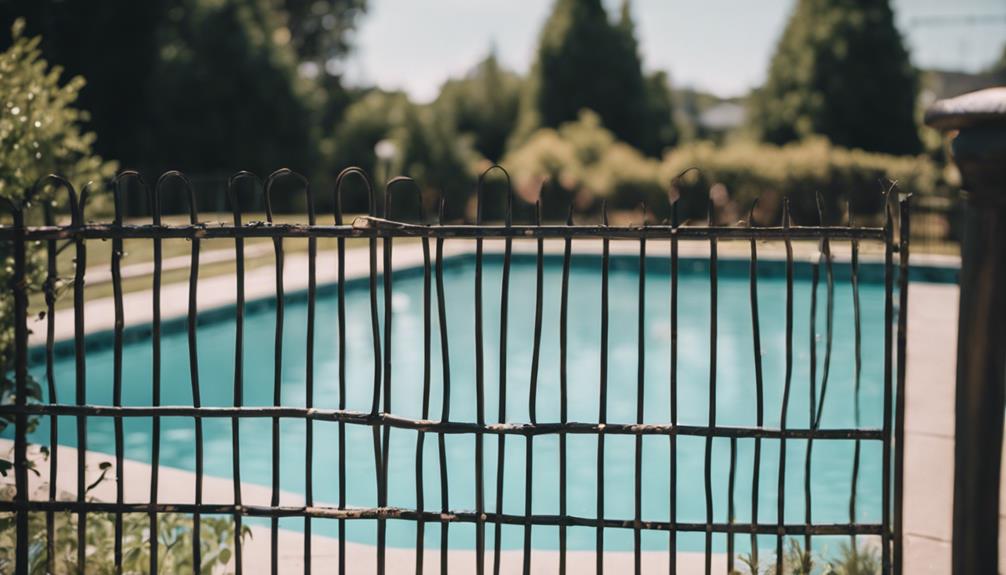
Inadequate pool barriers pose a significant risk to children's safety around swimming pools, contributing to over 50% of child drownings. To prevent such tragedies, installing a four-sided isolation fence is vital, as it reduces the risk of child drowning by 83%.
Children under 5 are particularly vulnerable when pool barriers are insufficient. It's recommended that pool barriers should be at least 48 inches high with no gaps or handholds that a child could use to climb over.
Additionally, ensuring that the pool cover is in good condition and used properly is essential. A pool cover can act as an extra layer of protection, especially when the pool isn't in use.
Importance of Swimming Lessons

Considering the significant impact on drowning prevention, understanding the importance of swimming lessons is essential for ensuring water safety for children. Formal swim lessons have been shown to decrease the risk of drowning by a substantial 88%, particularly in the vulnerable age group of 1-4-year-olds. The American Academy of Pediatrics strongly recommends swim lessons as a pivotal layer of protection against drowning incidents in pools. These lessons not only teach children how to swim but also instill essential water safety awareness and boost their confidence around water bodies. Moreover, through swim lessons, children learn essential life-saving skills such as floating and treading water, which can be critical in emergencies. Below is a table summarizing the key points regarding the significance of swimming lessons in enhancing swimming pool safety:
| Key Points | Importance of Swimming Lessons |
|---|---|
| Decrease Drowning Risk | 88% less likely to drown |
| Recommended by American Academy of Pediatrics | Essential for water safety |
| Enhance Water Safety Awareness | Increases safety awareness |
| Teach Life-Saving Skills | Floating and treading water |
Risks of Alcohol and Glass

Drinking alcohol by the pool can impair your judgment and increase the likelihood of accidents. Additionally, having glass containers near the pool poses a serious risk of shattering and causing severe injuries to swimmers.
Remember to adhere to pool rules that often prohibit alcohol and glass to guarantee a safe swimming environment for everyone.
Alcohol Dangers
Alcohol consumption near swimming pools poses important risks due to its potential to impair judgment and coordination, increasing the likelihood of accidents and drowning incidents. When alcohol is consumed near water, the effects can be amplified, leading to poor decision-making and reduced physical abilities. This can be especially risky in aquatic environments where quick reflexes and clear thinking are essential for safety.
Many pool facilities have strict rules prohibiting alcohol consumption to prevent these hazards and guarantee the well-being of all swimmers. By adhering to these guidelines, you can help create a safer environment for yourself and others. Remember, staying sober while swimming or relaxing by the pool can greatly reduce the chances of accidents and emergencies.
Glass Hazards
Be cautious of the dangers posed by glass containers in swimming pool areas, as they can easily shatter and create sharp shards that pose serious risks to swimmers and pool users.
When it comes to glass hazards, remember these key points:
- Shattering Risk: Glass containers have a high likelihood of breaking, especially in bustling pool environments.
- Severe Injuries: The sharp shards from broken glass can cause deep cuts and injuries, leading to potential infections.
- Regulations: Many pool facilities, following guidelines from organizations like the American Red Cross, strictly prohibit glass containers to maintain a safe environment.
- Alcohol Influence: Combining alcohol consumption with glass near pools heightens the risk of accidents and drowning incidents due to impaired judgment and coordination.
- Enforcement: To promote pool safety, it's essential to enforce rules against alcohol and glass containers around the pool area, ensuring a secure and enjoyable swimming experience for all.
Electrical Hazards Near Water

Electrical hazards near water pose a significant risk, especially around pools. Poolside electrical safety is vital to prevent accidents and potential fatalities.
Make sure to properly install and maintain electrical equipment near water sources to minimize the risk of electric shock incidents.
Shock Risk by Water
Improperly installed or maintained electrical equipment near swimming pools can pose a significant shock risk due to the presence of water. Here are some key points to keep in mind:
- Electrical hazards: Faulty wiring or malfunctioning pool lights can increase the risk of electrocution.
- Regular inspection: It's vital to consistently inspect electrical components near water to guarantee safety.
- Safety regulations: Following safety codes and regulations for electrical equipment near pools is important to prevent accidents.
- Electrocution risk: The combination of water and electricity can be extremely dangerous, potentially leading to severe injuries.
- Preventative measures: Taking proactive steps to maintain and check electrical systems can help minimize the risk of shocks and keep the pool area safe for everyone.
Poolside Electrical Safety
Inspecting electrical components near water is essential to prevent hazards and guarantee a safe swimming environment, especially when considering poolside electrical safety. To keep children safe around pools, it's important to make sure that all electrical equipment is properly installed and maintained.
Electrical hazards near water pose a significant risk of electrocution, making it essential to follow strict regulations like the Virginia Graeme Baker Pool and Spa Safety Act (VGBA). Pool contractors play a key role in upholding electrical safety codes to prevent accidents and maintain pool safety standards.
Regular inspections and maintenance of electrical equipment are necessary to minimize the risk of serious injuries or fatalities. By staying vigilant and addressing any electrical concerns promptly, you can create a secure environment for everyone enjoying the pool.
Essential Pool Safety Equipment

Having essential pool safety equipment readily available can help guarantee a substantial difference in emergency situations and safeguard the overall well-being of swimmers. When using the pool, it's important to have the following items on hand:
- Body hooks and life rings: These tools provide immediate assistance to individuals in distress, helping to prevent accidents from escalating.
- Emergency contact information: Displaying this prominently near the pool area ensures that help can be swiftly summoned in case of an emergency.
- ADA-compliant pool lifts: Enhance accessibility for individuals with disabilities, promoting inclusivity and safety for all swimmers.
- State-specific safety equipment: Different states have varying requirements, so make sure you comply with local regulations to maintain a safe environment.
- Properly installed and maintained equipment: Regular checks and maintenance are essential to make sure that safety equipment functions effectively when needed, reducing potential risks significantly.
Proper Chemical Handling
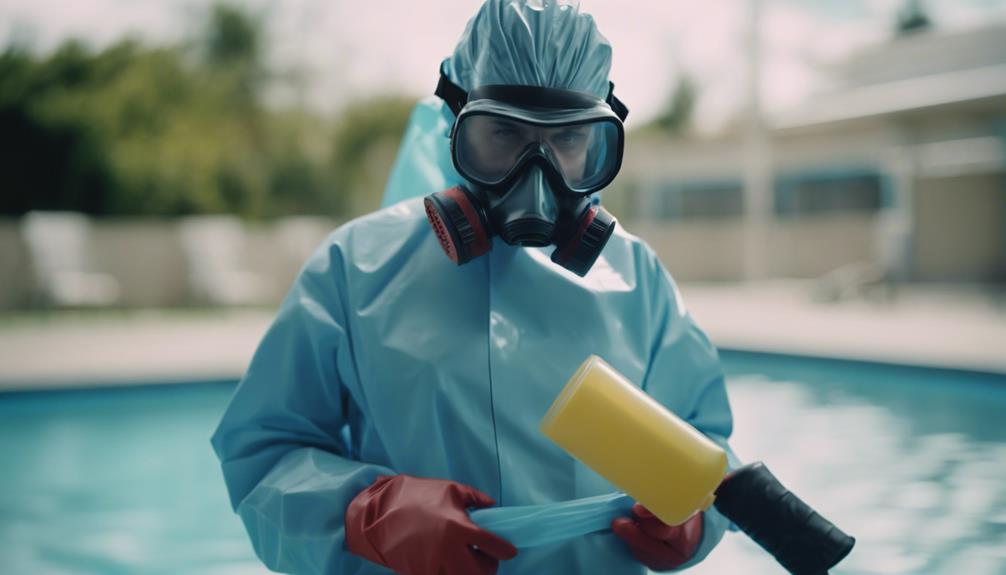
Maintaining adequate levels of chlorine and other disinfectants in your common pool is essential for ensuring a safe and clean environment for swimmers. These chemicals, like chlorine and bromine, are important for combating germs and keeping the water free from harmful bacteria.
To guarantee a healthy swimming environment, it's imperative to regularly test the chemical levels and adjust them as needed. Failing to handle pool chemicals properly can result in various health issues such as skin and eye irritation, respiratory problems, and even severe chemical burns.
Always follow the manufacturer's instructions for the correct usage, storage, and disposal of pool chemicals to prevent accidents and maintain a safe pool for everyone to enjoy. By staying vigilant with the chemical levels and handling procedures, you can create a swimming environment that isn't only clean but also free from potential health risks.
Compliance With Safety Regulations
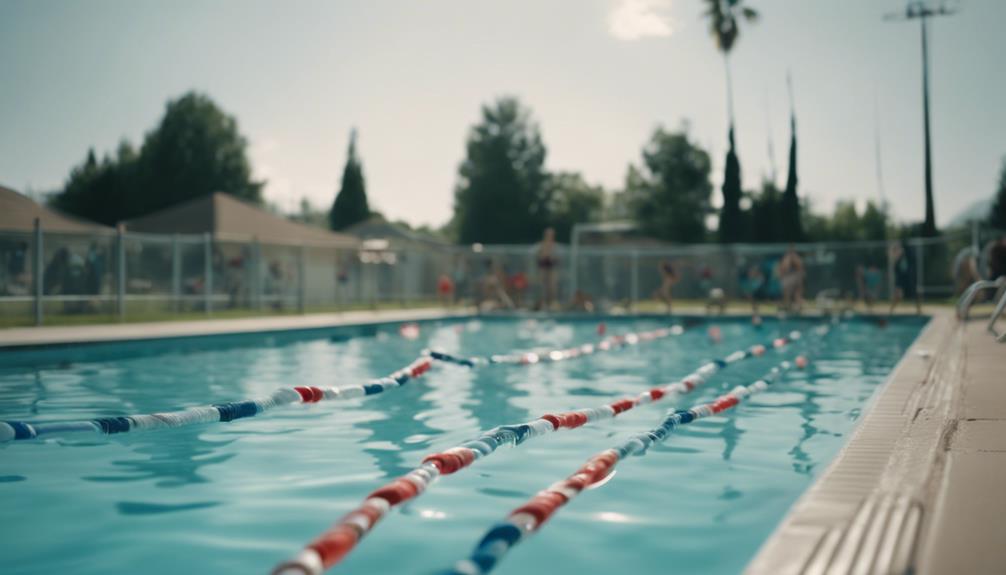
Adhering to state and local safety regulations is imperative for guaranteeing a secure swimming pool environment. When it comes to pool safety, here are five key points to make sure you comply with safety regulations:
- Regular Inspections: Conduct routine checks to confirm all safety equipment is functioning correctly.
- Proper Signage: Clearly display pool rules, depth markers, and emergency contact information.
- Safety Barriers: Install fences and gates to prevent unauthorized access to the pool area.
- Water Quality Testing: Regularly test the water to maintain proper chemical balance and clarity.
- Emergency Preparedness: Have a well-equipped first aid kit and rescue equipment easily accessible.
Frequently Asked Questions
What Are the Most Dangerous Natural Pools?
In natural pools, look out for strong currents, hidden hazards, and murky waters. Stay cautious of unpredictable conditions in rivers, lakes, and oceans. Lack of lifeguards and safety gear raises drowning risks. Be alert to prevent accidents.
What Type of Pool Is Safest?
For the safest pool, opt for one with safety features like alarms, covers, and fencing. These help prevent accidents. Above-ground pools are generally safer than in-ground due to lower drowning risk. Portable pools are safe when stored properly.
What Is One of the Greatest Risks in a Swimming Pool?
One of the greatest risks in a swimming pool is drowning, especially for young children. Constant supervision is vital, with 1 to 2-year-olds facing the highest death rates. Remember, safety measures like fences and swim lessons save lives.
What Is the Safety Rule in a Pool?
When in a pool, always follow safety rules. Adult supervision is a must for kids under 14. No diving, stick to occupancy limits, and heed posted signs. Comply with state and local regulations. Avoid alcohol and glass.
What Makes Some Swimming Pools More Dangerous Than Others?
Some swimming pools can be more dangerous than others due to the lack of proper safety measures to protect feet swimming pool safety. Pools without clearly marked depths, slippery surfaces, or inadequate fencing can pose significant risks. It’s essential for pool owners to prioritize safety to prevent accidents and injuries.
Conclusion
To summarize, safety should always be the top priority when it comes to swimming pools. By ensuring there's proper adult supervision, adequate barriers, and adherence to safety regulations, you can help prevent tragedies.
For example, a recent study showed that over 75% of child drownings occurred when there was a lack of supervision. Taking the necessary precautions and being vigilant can make all the difference in keeping everyone safe around the pool.
Stay informed and stay safe!

